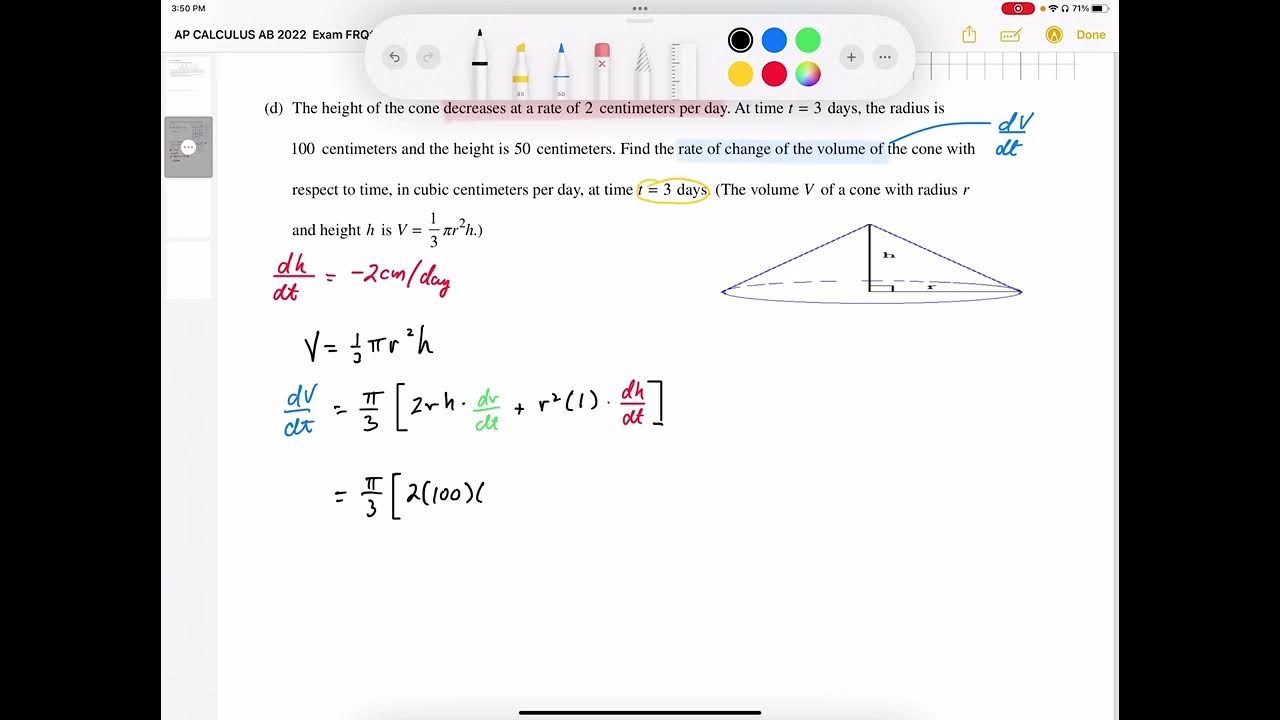2019 AP Calculus AB & BC Free Response #4
TLDRThe video script is a detailed walkthrough of problem number 4 from the 2019 AP Calculus AB and BC exams, focusing on a non-calculator section. The problem involves a water-filled cylinder with a changing water height due to drainage. The cylinder has a diameter of 2 feet, and the rate of change of the water height (dh/dt) is given as -1/10√h, with h in feet and time in seconds. The task is to find the rate of change of the water volume with respect to time when the water height is 4 feet. The solution involves differentiating the volume formula with respect to time, considering the constant radius of the cylinder, and substituting dh/dt with the given expression. The video also addresses whether the rate of change of the water height is increasing or decreasing by analyzing the second derivative of h with respect to time. Lastly, the problem asks to find an expression for the water height in terms of time using separation of variables, solving a differential equation, and applying the initial condition that at time 0, the water height is 5 feet.
Takeaways
- 📚 The problem is from the 2019 AP Calculus AB and BC exams, focusing on a non-calculator section involving a draining water cylinder.
- 🌊 The cylinder has a diameter of 2 feet, and the water height, H, is changing as it drains.
- ⏱️ The rate of change of the water height with respect to time, \( \frac{dh}{dt} \), is given as \( -\frac{1}{10} \sqrt{h} \) feet per second.
- 🔢 The volume formula for the cylinder is provided, and the task is to find the rate of change of the volume of water with respect to time, \( \frac{dV}{dt} \), when H is 4 feet.
- 🧮 To find \( \frac{dV}{dt} \), one must differentiate the volume formula with respect to time, considering the radius as a constant.
- 🔁 The derivative of \( \pi H \) with respect to time is \( \pi \frac{dH}{dt} \), and \( \frac{dh}{dt} \) is replaced by \( -\frac{1}{10} \sqrt{h} \) for evaluation.
- ⚖️ The units for \( \frac{dV}{dt} \) are derived from the units of the radius squared (feet squared) and the rate of change of height with respect to time (feet per second), resulting in cubic feet per second.
- 📈 For Part B, to determine if the rate of change of the water height is increasing or decreasing, the second derivative of H with respect to time is analyzed.
- 🔄 Using implicit differentiation and the chain rule, the second derivative of H with respect to time is found to be a constant, \( \frac{1}{200} \) feet per second per second.
- ↗️ Since the second derivative is positive, the rate of change of the water height is increasing when H is 3 feet.
- 🔢 Given the initial condition that at time 0 the height of the water is 5 feet, separation of variables is used to solve the differential equation for H in terms of T.
- ✅ The specific solution for H in terms of T is found by applying the initial condition, resulting in the function \( H(t) = (\sqrt{5} - \sqrt{t})^2 \).
Q & A
What is the diameter of the cylinder?
-The diameter of the cylinder is 2 feet.
What is the rate of change of the height of the water in the cylinder with respect to time?
-The rate of change of the height of the water, dh/dt, is equal to negative 1/10 times the square root of the height of the water (h).
How is the volume of the cylinder calculated?
-The volume of the cylinder is calculated using the formula V = πr^2h, where r is the radius and h is the height of the water.
What is the rate of change of the volume of water in the barrel when the height of the water is 4 feet?
-To find the rate of change of the volume (dV/dt) when the height is 4 feet, you would substitute h with 4 in the derivative of the volume formula and include the given dh/dt expression.
What units are associated with the rate of change of the volume of water in the barrel?
-The units for dV/dt are cubic feet per second (ft³/s), as it represents the volume change over time.
How can you determine if the rate of change of the height of the water is increasing or decreasing?
-You can determine this by analyzing the second derivative of the height with respect to time (d²h/dt²). If this value is positive, the rate of change is increasing; if negative, it is decreasing.
What is the second derivative of the height of the water with respect to time?
-The second derivative of the height with respect to time is found by differentiating dh/dt with respect to time, which results in a constant value of 1/200 ft/s².
At what height does the rate of change of the height of the water start to increase?
-The rate of change of the height of the water starts to increase when the height is 3 feet, as indicated by the second derivative being positive at that point.
What is the initial condition given for the height of the water at time zero?
-The initial condition given is that at time zero (t=0), the height of the water (H) is 5 feet.
How is the expression for H in terms of T found?
-The expression for H in terms of T is found by separating variables in the differential equation and solving for H, which involves integrating both sides of the equation.
What is the specific solution for the height of the water in terms of time?
-The specific solution for the height of the water in terms of time is obtained by applying the initial condition to the general solution, which gives H(t) = sqrt(C^2 - (1/10)t^2), where C is determined to be sqrt(5) from the initial condition.
How do you ensure that the units match up in the calculation of dV/dt?
-You ensure unit consistency by verifying that the units for the radius, height, and time are compatible when substituted into the volume formula and its derivative. The units for dV/dt should be consistent with the units for volume change per unit time.
Outlines
📚 Calculating the Rate of Change of Water Volume in a Cylinder
The first paragraph discusses problem number 4 from the 2019 AP Calculus AB and BC exams, which involves a draining water cylinder. The cylinder has a diameter of 2 feet, and the height of the water is changing due to drainage. The rate of change of the water height (dh/dt) is given as a function of the water height (h). The task is to find the rate of change of the volume of water with respect to time (dV/dt) when the water height is 4 feet. The solution involves differentiating the volume formula of a cylinder with respect to time, using the provided rate of change, and evaluating it at the specified height. The units of measurement are also discussed, emphasizing the importance of unit consistency in the calculation.
🔍 Analyzing the Rate of Change and Derivatives in a Draining Cylinder Problem
The second paragraph delves into the analysis of whether the rate of change of the water height is increasing or decreasing. This involves calculating the second derivative of the water height with respect to time. The process uses implicit differentiation and the chain rule, considering the relationship between dh/dt and h. The second derivative is found to be constant, indicating that the rate of change of the water height is consistently increasing. The paragraph also addresses solving a differential equation to express the water height as a function of time, using separation of variables. An initial condition is applied to find a specific solution, which describes how the height of the water changes over time starting from an initial height of 5 feet at time 0.
Mindmap
Keywords
💡AP Calculus
💡Cylinder
💡Diameter
💡Height of Water
💡Rate of Change
💡Volume Formula
💡Derivative
💡Implicit Differentiation
💡Chain Rule
💡Separation of Variables
💡Initial Condition
Highlights
Problem 4 from the 2019 AP Calculus AB and BC exams involves a draining water cylinder with a diameter of 2 feet.
The rate of change of the water's height (dh/dt) is given as negative 1/10 times the square root of the height (h).
The volume formula for the cylinder is provided, and the problem asks to find the rate of change of the volume with respect to time.
The rate of change of the volume (dV/dt) is derived without using the product rule due to the constant radius of the cylinder.
The derivative of the volume with respect to time is evaluated at a height of 4 feet.
The units of the rate of change of volume are cubic feet per second.
Part B of the problem asks whether the rate of change of the water's height is increasing or decreasing when the height is 3 feet.
The second derivative of the height with respect to time is calculated to determine the rate of change of the rate of change.
The second derivative is found to be constant, indicating a consistent rate of change of the water's height over time.
The rate of change of the height of the water is increasing when the height is 3 feet.
The problem provides an initial condition where the height of the water is 5 feet at time 0.
Separation of variables is used to find an expression for the height of the water in terms of time.
The differential equation is solved to obtain a general solution for the height of the water as a function of time.
The specific solution for the height of the water is found by applying the initial condition.
The constant of integration is determined to be the square root of 5.
The final function for the height of the water in terms of time is derived.
The problem demonstrates the application of calculus in modeling real-world scenarios, such as fluid dynamics.
The solution process involves understanding and applying concepts of derivatives, rates of change, and differential equations.
Transcripts
Browse More Related Video

AP CALCULUS AB 2022 Exam Full Solution FRQ#4d

Related Rates - Filling a Cone Problem

Related rates: water pouring into a cone | AP Calculus AB | Khan Academy

Learn how to solve a related rate of loosing water from a cone

Calculus gr 12 Exam Questions

How to solve a changing area of circle with related rates
5.0 / 5 (0 votes)
Thanks for rating: